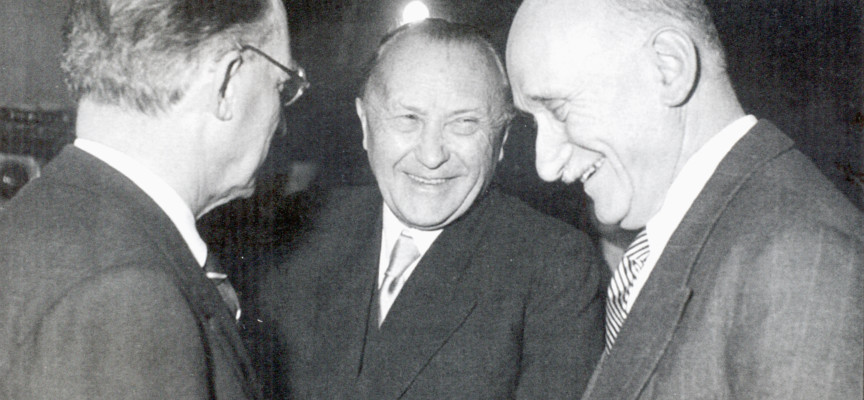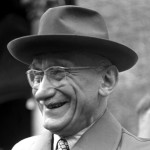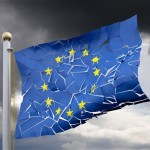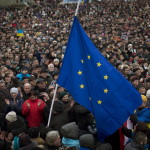We will soon commemorate the 60th anniversary of the Rome Treaties and current EU leaders will praise those men who made it possible. Pressed by growing Euro-scepticism, they may be tempted to idealise the clear and precise political vision that brought lasting peace to Europe through the Economic Community and Euratom. The reality is, however, that those treaties were not the original plan, but only an attempt to bring some oxygen to a dying community. In fact, the Rome Treaties were the outcome of flexibility, perseverance, and a friendship that blossomed in the search of the common good.
A peaceful revolution
It all began seven years earlier, when the French foreign minister Robert Schuman proposed a fresh new start to the leader of Western Germany, Konrad Adenauer. After World War II – and the many previous Franco-German wars, Schuman envisioned a new relation based on forgiveness, respect and fraternity, rather than retaliation and power. As soon as they met, these two Christian men knew that they could trust each other, and felt that Providence entrusted them with the mission of bringing about this peaceful revolution.
The specific plan came from Jean Monnet, who thought that the joint management of the coal and steel (which were feeding the war industry) would make war impossible between the partners. It was meant to be the first of a series of communities that would forever bind the peoples of Europe.
Common good: a binding goal
What shape should that united Europe take? They didn’t know. And they didn’t care so much. What was important was to walk the way together. What was important was to change the hearts of Europeans, so that they would build a real community. In Schuman’s words, “the community proposes the same objective to each partner, which the philosophy of St. Thomas calls ‘the common good’. This exists far from any egoistical motives. The good of each is the good of all and vice versa” (Robert Schuman. Du Lorrain des frontières au père de l’Europe, de François Roth. Ed. Fayard, 2008, p. 536).
When Alcide De Gasperi (Italy) and Paul-Henri Spaak in (Belgium) heard about this plan, they didn’t want to be left behind in the adventure. Despite belonging to different political families (Spaak being a Socialist, Adenauer, Schuman and De Gasperi Christian-Democrats), they believed that they had the moral duty to change the course of history. They put Europe above all national or partisan interests.
The human being at the centre
They had all lived through two world wars and were above 60 years of age. They were ready to sacrifice their own political careers and reputations to leave a legacy for future generations. Inspired by personalist philosophers such as Jacques Maritain and Emmanuel Mounier, they wanted to build a new society based on human dignity, respect for freedom and democracy, as well as a humane economic system with the person at the very core.
The Holocaust had made them very realistic about the fragility of good intentions. Societies fall too easily into hate and selfishness. This is why a system of negotiation should be institutionalized, making countries and persons so dependent of each other that war would become simply impossible.
The fiasco of a European Army
These men, however, tried to go too far too fast, and only two years after the European Coal and Steel Community (ECSC) was in place, they agreed on a European Defence Community (EDC). They imagined a common army, with a single command. In order to appoint the chief commander, they intended to establish a European Political Community (EPC). They drafted the treaties, and signed the first one. The history of Europe would have been very different had the French assembly not voted against ratification of the EDC. But it was rejected, and there was no plan B, so the founding fathers were devastated. They feared that the ECSC would stagnate and Europe would eventually go back to its old nationalistic ways. De Gasperi died shortly after the European Army fiasco, Schuman was replaced in the French foreign ministry and Adenauer thought that the European dream was over and he should turn to the United States.
The idea of a Common Market
And then the Dutch liberal Johan Willem Beyen came up with the idea of a common market, inspired by the strong cooperation of the Benelux countries. In the meantime, Monnet was working on another plan to revive the “community spirit”: an institution to jointly manage the peaceful use of atomic energy. The six partners discussed both projects. France did not like the common market, and Monnet was persuaded that it was premature to propose a common market. Germany, on the other hand, did not want anything to do with atomic energy and initially rejected Monnet’s plan.
Finally, the six found a compromise and they approved both projects in two different treaties. On 25th of March 1957, the signatories knew they were making history. The streets of Rome were filled with joy and hope, with posters around the city recalling the reason: “Six peoples, one family, for the good of all”. There should be no winner or loser, no division between rich and poor, north and south, only the dream of expanding the family by always renewing the “community spirit”. It would be the task of future Europeans to decide how to continue the quest for an ever-closer union.
(source: Europeinfos #202)
Ci sarà presto la commemorazione del 60° anniversario dei Trattati di Roma e gli attuali leader dell’UE tesseranno le lodi di quegli uomini che li hanno resi possibili. Sotto la pressione di un crescente euroscetticismo, potrebbero essere tentati di idealizzare la visione politica chiara e precisa che ha portato la pace duratura in Europa attraverso la Comunità economica e l’Euratom. La realtà è, tuttavia, che quei trattati non erano il piano originale, ma solo un tentativo di portare un po’ di ossigeno a una comunità in agonia. In realtà, i Trattati di Roma erano il risultato di flessibilità, perseveranza, e un’amicizia fiorita nella ricerca del bene comune.
Una rivoluzione pacifica
Era cominciato tutto sette anni prima, quando il ministro degli esteri francese Robert Schuman aveva proposto al leader della Germania occidentale, Konrad Adenauer, un nuovo inizio. Dopo la seconda guerra mondiale, e le numerose guerre franco-tedesche precedenti, Schuman immaginava un nuovo rapporto basato sul perdono, il rispetto e la fraternità, al posto della ritorsione e del potere. Non appena s’incontrarono, questi due cristiani capirono che potevano fidarsi l’uno dell’altro, e sembrò che la Provvidenza avesse affidato loro la missione di realizzare questa rivoluzione pacifica.
Il progetto specifico fu di Jean Monnet, che pensava che la gestione congiunta del ferro e dell’acciaio (che alimentavano l’industria della guerra) avrebbe reso impossibile la guerra tra i partner. Doveva essere la prima di una serie di comunità che avrebbero per sempre legato i popoli dell’Europa.
Il bene comune: un obiettivo vincolante
Che forma avrebbe assunto quell’Europa unita? Non lo sapevano. E non se ne preoccuparono molto. La cosa importante era camminare insieme. La cosa importante era cambiare i cuori degli europei in modo da costruire una vera comunità. Come disse Schuman, “la comunità propone gli stessi obiettivi a ciascun partner, cosa che la filosofia di San Tommaso chiama ‘il bene comune’. Esso è lontano da qualsiasi movente egoistico. Il bene di ciascuno è il bene di tutti e viceversa”. (Robert Schuman. Du Lorrain des frontières au père de l’Europe, de François Roth. Ed. Fayard, 2008, p. 536)
Quando Alcide De Gasperi (Italia) e Paul-Henri Spaak (Belgio) sentirono parlare di questo progetto, non vollero rimanere fuori dall’avventura. Nonostante appartenessero a famiglie politiche diverse (Spaak era un socialista, Adenauer, Schuman e De Gasperi cristiano-democratici), erano convinti di avere il dovere morale di cambiare il corso della storia. Misero l’Europa al di sopra di tutti gli interessi nazionali o partigiani.
L’essere umano al centro
Avevano tutti vissuto due guerre e avevano più di 60 anni. Erano pronti a sacrificare la propria carriera politica e la propria reputazione per lasciare un’eredità alle generazioni future. Ispirati da filosofi personalisti come Jacques Maritain ed Emmanuel Mounier, volevano costruire una nuova società basata sulla dignità umana, sul rispetto della libertà e della democrazia e un sistema economico umano con la persona al centro.
L’olocausto li aveva resi molto realisti riguardo la fragilità delle buone intenzioni: le società piombano troppo facilmente nell’odio e nell’egoismo. Per questo bisognava istituzionalizzare un sistema di negoziazioni, rendendo le persone e gli Stati così dipendenti gli uni dagli altri da rendere la guerra semplicemente impossibile.
Il fiasco di un esercito europeo
Questi uomini, tuttavia, hanno cercato di andare troppo in fretta troppo lontano, e solo due anni dopo la nascita della Comunità europea del carbone e dell’acciaio (CECA), hanno concordato una Comunità europea di difesa (CED). Hanno immaginato un esercito comune, con un comando unico. Al fine di nominare il comandante in capo, avevano intenzione di creare una Comunità politica europea (CPE). Essi prepararono i trattati, e firmarono il primo. La storia dell’Europa sarebbe stata molto diversa se l’assemblea francese non avesse votato contro la ratifica della CED. Ma è stata respinta, e non avendo nessun piano B, i padri fondatori restarono a piedi. Temevano che la CECA avrebbe ristagnato e che l’Europa sarebbe poi tornata al suo vecchio stile nazionalistico. De Gasperi morì poco dopo il fiasco dell’esercito europeo, Schuman fu sostituito nel ministero degli esteri francese e Adenauer pensò che il sogno europeo fosse finito e che avrebbe dovuto guardare agli Stati Uniti.
L’idea del mercato comune
E poi arrivò il liberale olandese Johan Willem Beyen con l’idea di un mercato comune, ispirato alla forte cooperazione dei paesi del Benelux. Nel frattempo Monnet stava lavorando a un altro progetto per rilanciare lo “spirito comunitario”: un’istituzione per gestire congiuntamente l’uso pacifico dell’energia atomica. I sei partner discussero entrambi i progetti. La Francia non accettò il mercato comune, poiché Monnet era convinto che fosse prematuro proporre un mercato comune. La Germania, d’altra parte, non voleva avere niente a che fare con l’energia atomica e inizialmente respinse il piano di Monnet. Alla fine, i sei trovarono un compromesso e approvarono entrambi i progetti in due trattati diversi.
Il 25 marzo 1957 i firmatari sapevano che stavano facendo la storia. Le strade di Roma erano piene di gioia e di speranza, con manifesti in tutta la città che ne ricordano il motivo: “Sei popoli, una sola famiglia, per il bene di tutti”. Non ci sarebbero dovuti essere vincitori o perdenti, nessuna divisione tra ricchi e poveri, nord e sud, solo il sogno di allargare la famiglia rinnovando sempre lo “spirito comunitario”. Sarebbe stato compito dei futuri cittadini europei decidere come continuare la ricerca di un’unione sempre più stretta.
(fonte: Europeinfos #202; traduzione italiana a cura di Eurcom)
Les Traités de Rome, une histoire de succès
Nous allons commémorer d’ici peu le 60ème anniversaire des Traités de Rome et les dirigeants actuels de l’Union européenne vont faire l’éloge des hommes qui ont rendu possible l’établissement de ces traités. Sous la pression d’un euro-scepticisme grandissant, ils pourraient être tentés d’idéaliser la vision politique claire et précise qui a apporté à l’Europe une paix durable grâce à la Communauté économique et à Euratom. Mais la réalité, c’est que ces traités n’étaient pas le plan d’origine mais seulement une tentative d’apporter un peu d’oxygène à une communauté qui périclitait. En fait, les Traités de Rome sont le fruit de la flexibilité, de la persévérance et d’une amitié qui s’est épanouie dans la recherche du bien commun.
Une révolution pacifique
Tout avait commencé sept ans plus tôt, lorsque le ministre français des affaires étrangères, Robert Schuman, a proposé un tout nouveau départ au dirigeant de l’Allemagne de l’ouest Konrad Adenauer. Après la seconde guerre mondiale et les nombreuses guerres franco-allemandes qui l’avaient précédée, Schuman a imaginé une nouvelle relation fondée sur le pardon, le respect et la fraternité plutôt que sur les représailles et la puissance. Dès qu’ils se sont rencontrés, ces deux chrétiens ont su qu’ils pouvaient se faire confiance et ont senti que la Providence leur avait confié la mission de faire advenir cette révolution pacifique.
Concrètement, le plan est venu de Jean Monnet, qui a pensé que la gestion commune du charbon et de l’acier (deux ressources qui alimentaient l’industrie de la guerre) rendrait la guerre impossible entre les partenaires. L’idée était de faire de cette communauté charbon-acier la première d’une série de communautés qui lieraient à jamais les peuples d’Europe.
Le bien commun: un objectif rassembleur
Mais quelle forme fallait-il que prenne l’Europe unie ? Ils n’en savaient rien. Et ce n’était guère important à leurs yeux. Ce qui leur importait, c’était de cheminer ensemble. Ce qui leur importait, c’était de changer le cœur des Européens afin qu’ils puissent construire une véritable communauté. Comme le disait Robert Schuman, “la communauté propose à chaque partenaire un même objectif, appelé « le bien commun » dans la philosophie de saint Thomas. Il se situe en dehors de toute finalité égoïste. Le bien de chacun est le bien de tous, et réciproquement”. (François Roth: Robert Schuman. Du Lorrain des frontières au père de l’Europe, Paris 2008 – S. 536).
Lorsqu’Alcide De Gasperi (Italie) et Paul-Henri Spaak (Belgique) ont entendu parler de ce plan, ils n’ont pas voulu être laissés pour compte dans cette aventure. Même s’ils appartenaient à des familles politiques différentes (Spaak était socialiste tandis qu’Adenauer, Schuman et De Gasperi étaient démocrates-chrétiens), tous étaient convaincus qu’ils avaient le devoir moral de changer le cours de l’histoire. Ils ont mis l’Europe au-dessus de tous les intérêts nationaux ou partisans.
L’humain au cœur des préoccupations
Ils avaient tous vécu deux guerres mondiales et avaient plus de 60 ans. Ils étaient prêts à sacrifier leur réputation personnelle et leur propre carrière politique pour laisser un héritage aux générations à venir. Inspirés par des philosophes personnalistes tels que Jacques Maritain ou Emmanuel Mounier, ils voulaient construire une société nouvelle reposant sur la dignité humaine, le respect de la liberté et la démocratie ainsi que sur un système économique humaniste, centré sur la personne.
La Shoah les avait rendus d’un grand réalisme à l’égard de la fragilité des bonnes intentions. Les sociétés glissent trop aisément vers la haine et l’égoïsme. C’est pourquoi ils considéraient qu’il fallait institutionnaliser un système de négociations qui rendrait les pays et les personnes tellement dépendants les uns des autres que la guerre deviendrait tout simplement impossible.
Mais ces hommes ont essayé d’aller trop loin trop vite, et deux ans seulement après la mise en place de la Communauté européenne du charbon et de l’acier (CECA), ils se sont mis d’accord sur l’établissement d’une Communauté européenne de défense (CED). Ils ont imaginé une armée commune, placée sous un commandement unique. Afin de nommer le commandant en chef, ils ont voulu établir une Communauté politique européenne (CPE). Ils ont élaboré les Traités et signé le premier. L’histoire de l’Europe aurait été fort différente si l’Assemblée nationale française n’avait pas voté contre la ratification de la CED. Mais la proposition a été rejetée et il n’y avait pas de plan B, ce qui a porté un coup terrible aux pères fondateurs de l’Europe. Ils avaient peur que la CECA ne stagne et que l’Europe n’en revienne en fin de compte à ses vieux démons nationalistes. De Gasperi est décédé peu de temps après le fiasco de l’armée européenne, Schuman a été remplacé au ministère français des affaires étrangères et Adenauer a pensé que le rêve européen était fini et qu’il devait se tourner vers les Etats-Unis.
L’idée d’un marché commun
C’est alors que le libéral hollandais Johan Willem Beyen a eu l’idée d’un marché commun, inspiré par l’étroite coopération entre les pays du Benelux. Dans l’intervalle, Jean Monnet travaillait à l’élaboration d’un autre plan pour raviver “l’esprit communautaire”, à savoir une institution qui gérerait en commun l’usage pacifique de l’énergie atomique. Les six partenaires ont discuté des deux projets. La France n’aimait pas l’idée d’un marché commun et Monnet était persuadé c’était prématuré. L’Allemagne, en revanche, ne voulait pas entendre parler de l’énergie atomique et a rejeté initialement le plan de Monnet.
Finalement, les six ont trouvé un compromis et approuvé les deux projets en deux traités différents. Le 25 mars 1957, les signataires étaient conscients d’écrire une page d’histoire. Les rues de Rome étaient pleines de joie et d’espoir et des affiches dans toute la ville en rappelaient la raison : “Six peuples, une seule famille, pour le bien de tous”. Il ne devait y avoir ni gagnant ni perdant, ni division entre riches et pauvres ou entre nord et sud, seulement le rêve d’un agrandissement de la famille en renouvelant toujours “l’esprit communautaire”. Il appartient désormais aux futurs Européens de décider de quelle manière ils veulent continuer la quête d’une union toujours plus étroite.
(source: Europeinfos #202)
Die Römischen Verträge, eine Erfolgsgeschichte
Wir werden bald den 60. Jahrestag der Unterzeichnung der Römischen Verträge begehen, und die aktuellen Spitzenpolitiker der EU werden voll des Lobes für jene Männer sein, die einst diese Verträge möglich machten. Unter dem Druck einer wachsenden Europaskepsis werden sie vielleicht versucht sein, die klare und präzise politische Vision, die Europa durch die Wirtschaftsgemeinschaft und Euratom dauerhaften Frieden brachte, zu verklären. Die Realität sieht allerdings so aus, dass jene Verträge nicht den eigentlichen Plan widerspiegelten, sondern ein Versuch waren, eine dahinsiechende Gemeinschaft mit etwas Sauerstoff zu revitalisieren. So waren die Römischen Verträge tatsächlich das Ergebnis von Flexibilität, Beharrlichkeit und einer Freundschaft, die bei der Suche nach dem Gemeinwohl aufblühte.
Eine friedliche Revolution
All dies begann sieben Jahre zuvor, als der französische Außenminister Robert Schuman dem deutschen Bundeskanzler Konrad Adenauer einen kompletten Neubeginn vorschlug. Nach dem Zweiten Weltkrieg – und all den vorherigen Kriegen zwischen Deutschland und Frankreich – träumte Schuman von einer neuen Beziehung auf der Basis von Vergebung, Respekt und Brüderlichkeit statt Vergeltung und Macht. Schon bei ihrem ersten Zusammentreffen wussten diese beiden christlich geprägten Männer, dass sie einander vertrauen konnten, und sie waren sich sicher, dass die Fügung ihnen den Auftrag anvertraut hatte, diese friedliche Revolution herbeizuführen.
Der ganz konkrete Plan kam von Jean Monnet, nach dessen Auffassung eine gemeinsame Kontrolle der Kohle- und Stahlproduktion – einer wichtigen Grundlage der Rüstungsindustrie – den Ausbruch eines erneuten Krieges zwischen den Partnern unmöglich machen würde. Die Montanunion war die erste einer Reihe von Gemeinschafen, die für alle Zeit die Völker Europas aneinander binden würde.
Das verbindende Ziel des Gemeinwohls
Welche Form sollte nun das vereinte Europa annehmen? Darauf hatten sie keine Antwort. Und es spielte für sie auch keine allzu große Rolle. Was für sie zählte, war, dass sie sich gemeinsam auf den Weg machten. Und wichtig war es auch, die Herzen der Europäer zu erreichen, so dass sie zu einer echten Gemeinschaft zusammenwachsen würden. In Schumans Worten hieß dies: „Die Gemeinschaft schlägt jedem Partner das gleiche Ziel vor, das in der Philosophie des Heiligen Thomas von Aquin ‚Gemeinwohl’ lautet. Dieses existiert fernab jeglicher egoistischer Motive. Das Wohl jedes Einzelnen ist das Wohl aller und umgekehrt” (François Roth: Robert Schuman. Du Lorrain des frontières au père de l’Europe, Paris 2008 – S. 536).
Als Alcide De Gasperi (Italien) und Paul-Henri Spaak (Belgien) von diesem Plan hörten, wollten sie bei dem Abenteuer dabei sein. Trotz eines unterschiedlichen politischen Hintergrunds (Spaak war Sozialdemokrat, Adenauer, Schuman und De Gasperi Christdemokraten) sahen sie sich in der moralischen Pflicht, den Lauf der Geschichte mitzugestalten. Sie setzten Europa über alle nationalen oder partikulären Interessen.
Der Mensch im Mittelpunkt
Sie alle hatten zwei Weltkriege erlebt und waren über 60 Jahre alt. Sie waren bereit, ihre eigene politische Karriere und ihren Ruf aufs Spiel zu setzen, um den zukünftigen Generationen ein Vermächtnis zu hinterlassen. Inspiriert von personalistischen Philosophen wie Jacques Maritain und Emmanuel Mounier, wollten sie eine auf Menschenwürde, Achtung der Freiheit und Demokratie basierende neue Gesellschaft errichten und gleichzeitig ein humanes Wirtschaftssystem schaffen, bei dem der Mensch im Mittelpunkt steht.
Durch den Holocaust waren sie sehr realistisch geworden, was die Dauerhaftigkeit von guten Absichten betrifft. Gesellschaften verfallen allzu schnell in Hass und Egoismus. Daher sollte ein Verhandlungssystem institutionalisiert werden, durch das Länder und Menschen derart voneinander abhängig würden, dass ein Krieg schlichtweg unmöglich würde.
Das Fiasko der europäischen Armee
Doch diese Männer wollten in zu kurzer Zeit zu viel erreichen, und nur zwei Jahre, nachdem die Europäische Gemeinschaft für Kohle und Stahl (EGKS, Montanunion) in Kraft getreten war, gründeten sie die Europäische Verteidigungsgemeinschaft (EVG). Dabei stellten sie sich eine gemeinsame Armee unter einer einzigen Führung vor. Zur Ernennung des Obersten Befehlshabers wollten sie eine Europäische Politische Gemeinschaft errichten (EPG). Sie entwarfen die Verträge und unterzeichneten den ersten.
Die europäische Geschichte hätte einen ganz anderen Lauf genommen, hätte die französische Nationalversammlung nicht gegen die Ratifizierung des EVG-Vertrags gestimmt. Die Europäische Verteidigungsgemeinschaft scheiterte, ohne dass es einen Plan B gab. Die Gründerväter waren erschüttert, denn sie befürchteten ein Stagnieren der EGKS und schließlich einen Rückfall Europas in den früheren Nationalismus. De Gasperi verstarb kurz nach dem Fiasko der europäischen Armee, Schuman wurde im französischen Außenministerium ersetzt, und Adenauer hielt den europäischen Traum für geplatzt und wandte sich stattdessen den Vereinigten Staaten zu.
Die Idee des gemeinsamen Marktes
Doch dann brachte der niederländische Liberale Johan Willem Beyen, inspiriert durch die enge Kooperation innerhalb der Benelux-Staaten, die Idee eines gemeinsamen Marktes auf. Gleichzeitig arbeitete Monnet an einem anderen Plan, um den „Gemeinschaftsgeist” neu zu beleben: die Schaffung einer Institution, dank derer die friedliche Nutzung der Atomenergie gemeinsam bewerkstelligt werden könne. Die sechs Partner diskutierten beide Projekte. Frankreich mochte den gemeinsamen Markt nicht, und Monnet war überzeugt, dass dieser Vorschlag eines gemeinsamen Marktes verfrüht sei. Deutschland hingegen wollte nichts mit Atomenergie zu tun haben und lehnte daher zunächst Monnets Plan ab.
Letztendlich fanden die sechs einen Kompromiss und billigten beide Projekte in unterschiedlichen Verträgen. Am 25. März 1957 wussten die Unterzeichner, dass sie Geschichte schrieben. Auf den Straßen Roms waren die Menschen voller Freude und Hoffnung; den Grund dafür konnte man überall in der Stadt auf Plakaten lesen: „Sechs Völker, eine Familie, zum Wohle aller“. Es sollte keine Gewinner und Verlierer, keine Kluft zwischen Reich und Arm, zwischen Nord und Süd geben – nur den Traum, dass diese Familie noch weiter wächst, indem der „Gemeinschaftsgeist“ immer wieder neu entfacht wird. Die Entscheidung darüber, wie dieses Streben nach einem immer enger werdenden Bund fortgesetzt werden könne, sollte bei den künftigen Europäern liegen.
(quelle: Europeinfos #202)
Victoria Martin de la Torre
Latest posts by Victoria Martin de la Torre (see all)
- The Rome Treaties, a successful story - 10 marzo 2017











